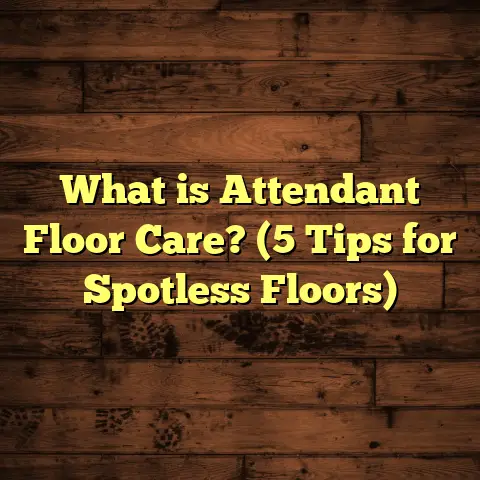What is Cupping on Hardwood Floors? (5 Causes & 7 Solutions)
When I think about hardwood floors, I immediately picture kids running barefoot across them, their joyful footsteps filling the room. Hardwood floors add a natural warmth and charm to family spaces, making memories all the more special. But sometimes, the charm gets interrupted by an annoying problem called cupping. If you’ve ever noticed your hardwood floorboards curling up at the edges, making the floor feel uneven, then you know exactly what I’m talking about.
In this article, I’ll walk you through everything I’ve learned about cupping on hardwood floors—from what it really is, to why it happens, to how you can fix or prevent it. I’ll share my personal experiences with homeowners, data-backed insights from industry experts, and detailed technical explanations so you feel confident handling this issue yourself or with your contractor.
What is Cupping on Hardwood Floors?
Let’s start with the basics. Cupping is a specific type of distortion in hardwood floorboards where the edges of each plank rise higher than the center, creating a shape that looks like a shallow bowl or cup. Imagine placing a flat board on a table and then having its edges bend upward—this is precisely what happens with cupping.
How Cupping Looks and Feels
If you run your hand across a cupped floor, you’ll feel the raised edges and a dip in the middle of each board. Walking on it can feel bumpy or uneven because your feet don’t hit a flat surface. Visually, it can look like the floor is warping or buckling.
Why Does This Happen?
The root cause lies in wood’s natural behavior as a hygroscopic material—it absorbs and releases moisture depending on its environment. Wood fibers expand mainly across the grain when moist and shrink when dry.
When the bottom side of a wood plank absorbs more moisture than the top side, it causes uneven swelling. The bottom expands more, pushing the edges up and bending the board into a cup shape.
Solid vs. Engineered Hardwood
Understanding the difference between solid hardwood and engineered hardwood helps explain how cupping occurs differently in each.
- Solid Hardwood: These planks are milled from a single piece of wood, typically 3/4 inch thick. They are more susceptible to moisture changes because they’re all solid wood.
- Engineered Hardwood: Made of multiple layers (usually 3-12 layers) glued together with the grain alternating between layers. The top layer is hardwood veneer. This layered construction makes engineered hardwood more dimensionally stable but not immune to moisture issues.
Manufacturing and Kiln Drying
During manufacturing, solid hardwood is kiln-dried to reduce moisture content to about 6-9%. This drying stabilizes wood to typical indoor conditions before installation. Engineered hardwood also undergoes drying and adhesive curing processes during manufacturing.
If these drying steps are skipped or insufficient, or if moisture conditions change drastically after installation, cupping can develop.
Why Should You Care About Cupping? A Personal Story
I had a client recently whose kids loved playing soccer indoors. The hardwood floor was their favorite spot for games and family dance-offs. One day, they noticed the floor felt uneven underfoot—the edges of some boards were raised dangerously high. The kids tripped a few times, and mom was worried about safety.
We discovered significant cupping caused by excessive moisture from a hidden pipe leak beneath the floor. Fixing this wasn’t just about aesthetics; it was about restoring a safe space for those kids to play freely.
This experience reminded me how flooring problems affect daily life—especially for families with children who rely on safe, comfortable floors for play and relaxation.
Five Common Causes of Hardwood Floor Cupping
If cupping happens in your home, it’s usually due to one or more moisture-related issues combined with certain installation or maintenance mistakes. Let me break down the causes I encounter most frequently:
1. Excessive Moisture or Water Intrusion
Water under your floors is like kryptonite for hardwood. Whether from plumbing leaks, flooding, or spills that seep into cracks, water saturates the subfloor and the bottom surfaces of the boards.
This causes those bottom layers to swell while the top remains drier—leading to that classic cupped shape.
A Case Study:
A family in Texas experienced severe cupping after a sump pump failure flooded their basement floor. Moisture tests showed subfloor moisture levels above 20%, while surface readings stayed under 10%. After removing damaged boards and drying out the area with commercial dehumidifiers, they replaced flooring with engineered hardwood designed for moisture resistance.
2. High Indoor Humidity Levels
High relative humidity (RH) in your home means wood continuously absorbs moisture from the air. Humidity above 60% is particularly risky for hardwood floors.
I’ve seen homes in coastal or tropical climates where humidity spikes seasonally cause cyclical cupping and crowning (the opposite condition where board centers rise).
According to data from the National Wood Flooring Association (NWFA), maintaining RH between 30-50% helps prevent most moisture-related problems.
3. Poor Acclimation Before Installation
Acclimation is allowing flooring materials to adjust to your home’s temperature and humidity before installation. Skipping this step or rushing it causes boards to expand or contract later inside your home.
In one project I worked on, installers delivered freshly milled oak flooring straight from a humid warehouse into a dry heated house without acclimation. Within weeks, multiple rooms developed cupping due to internal moisture imbalances in the wood.
4. Inadequate Subfloor Moisture Barrier
Concrete slabs naturally release moisture vapor upward after curing—sometimes for years. Without vapor barriers like polyethylene sheets or liquid sealers under your floor, moisture moves into wood.
Studies show untreated concrete can emit 3-6 pounds of water per 1,000 square feet daily—enough to saturate flooring without protection.
5. Improper Cleaning Practices
Many homeowners underestimate how much water they use when cleaning floors. Mopping with excessive water or using steam cleaners regularly saturates wood surfaces.
One client shared how their weekly steam cleaning routine caused noticeable cupping within six months—something I always warn against during consultations.
Digging Deeper: The Science Behind Wood Moisture Movement
Wood’s dimensional changes result from its cellular structure filled with tiny capillaries that absorb water molecules from air or liquid sources.
- Fiber Saturation Point (FSP): Around 30% moisture content where cell walls are saturated but cell cavities are empty.
- Below FSP, wood shrinks as it loses moisture.
- Above FSP, wood swells as it gains moisture.
Most hardwood floors operate between 6-9% moisture content indoors—well below FSP—but fluctuations happen with changing seasons and weather patterns.
The differential moisture content between top and bottom surfaces of boards causes internal stresses that physically warp the wood—cupping being a common outcome.
Seven Solutions for Fixing and Preventing Hardwood Floor Cupping
Now that you know what causes cupping let’s talk solutions—both for fixing existing problems and avoiding future ones based on my years of experience as a flooring contractor.
1. Control Indoor Humidity Levels
This is step one for any home with hardwood flooring.
- Use humidifiers in winter when indoor air dries out.
- Use dehumidifiers during humid summers.
- Aim to keep humidity between 30-50% year-round.
- Use hygrometers around your home to monitor conditions.
I recommend smart HVAC systems with humidity sensors that automatically adjust settings based on real-time data.
2. Improve Ventilation and Airflow
Good airflow reduces trapped moisture under floors and in basements or crawl spaces.
- Ensure vents aren’t blocked.
- Add fans or air exchangers if needed.
- Open windows periodically to circulate fresh air when weather permits.
These simple steps prevent stagnant moist air buildup that can lead to cupping.
3. Allow Proper Acclimation Before Installation
Never skip acclimation!
- Store wood flooring inside your home for at least 72 hours before installation.
- Stack planks with spacers to allow airflow.
- Measure moisture content of wood and subfloor to confirm compatibility before laying down boards.
Proper acclimation reduces surprises after installation because wood is already adjusted to your home’s environment.
4. Install Vapor Barriers Underneath Floors
This is critical when installing over concrete slabs or damp crawl spaces.
- Use polyethylene sheeting (6 mil thickness minimum).
- Seal seams tightly.
- Consider liquid-applied vapor retarders for added protection.
A quality vapor barrier blocks ground moisture from reaching your flooring layers.
5. Repair Water Leaks Promptly
Quickly fixing leaking pipes, appliances, or roof leaks stops water intrusion early before serious damage occurs.
I always advise homeowners to check under sinks, behind appliances, and around plumbing regularly for signs of moisture buildup.
6. Clean Hardwood Floors Correctly
Avoid excessive water or steam cleaning methods.
Use:
- Dry dust mops.
- Slightly damp microfiber mops.
- Manufacturer-recommended cleaning products designed for hardwood floors.
Promptly wipe up spills with dry cloths to prevent water sitting on floorboards.
7. Sanding and Refinishing When Needed
If cupping is minor to moderate and boards are intact:
- Sand down raised edges.
- Refinish with high-quality polyurethane sealers.
This restores smooth surfaces and adds protective layers against moisture penetration.
Detailed Case Study: Fixing Severe Cupping in a Coastal Home
A client living near the Gulf Coast faced ongoing cupping problems due to extremely high indoor humidity (often above 70%) combined with inadequate vapor barriers installed years ago.
We took these steps:
- Removed existing flooring.
- Tested subfloor moisture content (readings were upwards of 18%).
- Installed a 10-mil vapor barrier with sealed seams.
- Chose engineered hardwood specifically rated for coastal environments.
- Installed whole-house dehumidifiers synced with HVAC system.
- Educated homeowners on cleaning practices and humidity monitoring.
Six months later:
- No new cupping appeared.
- Floors remained flat despite summer humidity spikes.
- Homeowners reported greater comfort and fewer maintenance worries.
Unique Insights & Tips From My Experience
- Some species like oak, maple, and hickory are more prone to cupping due to their grain structure.
- Engineered hardwood with thicker wear layers offers better durability but still needs moisture control.
- Floating floors (not nailed/glued) can sometimes reduce cupping risks by allowing boards to move slightly.
- Always use professional-grade moisture meters during inspections—you’d be surprised how many flooring problems trace back to unseen moisture issues.
The Future of Hardwood Flooring: Innovations Against Cupping
Manufacturers are improving products by:
- Using advanced adhesives and multilayer constructions in engineered hardwood.
- Pre-sealing planks during manufacturing to reduce water absorption.
- Creating hybrid products combining vinyl bases with hardwood surfaces for stability.
These innovations reduce cupping risk but don’t replace good installation practices and home maintenance.
Final Thoughts: Keeping Your Floors Happy and Flat
Cupping might feel overwhelming at first if you notice it in your home. But understanding why it happens helps you take control rather than stress over it.
From controlling humidity to choosing proper flooring materials and cleaning methods, small efforts pay off big in preserving your floors’ beauty and safety—especially if you have little feet running around making memories every day like mine do.
Have you dealt with hardwood floor cupping? What worked for you? Feel free to share stories or ask questions—I’m here to help keep your floors looking smooth for years to come!





